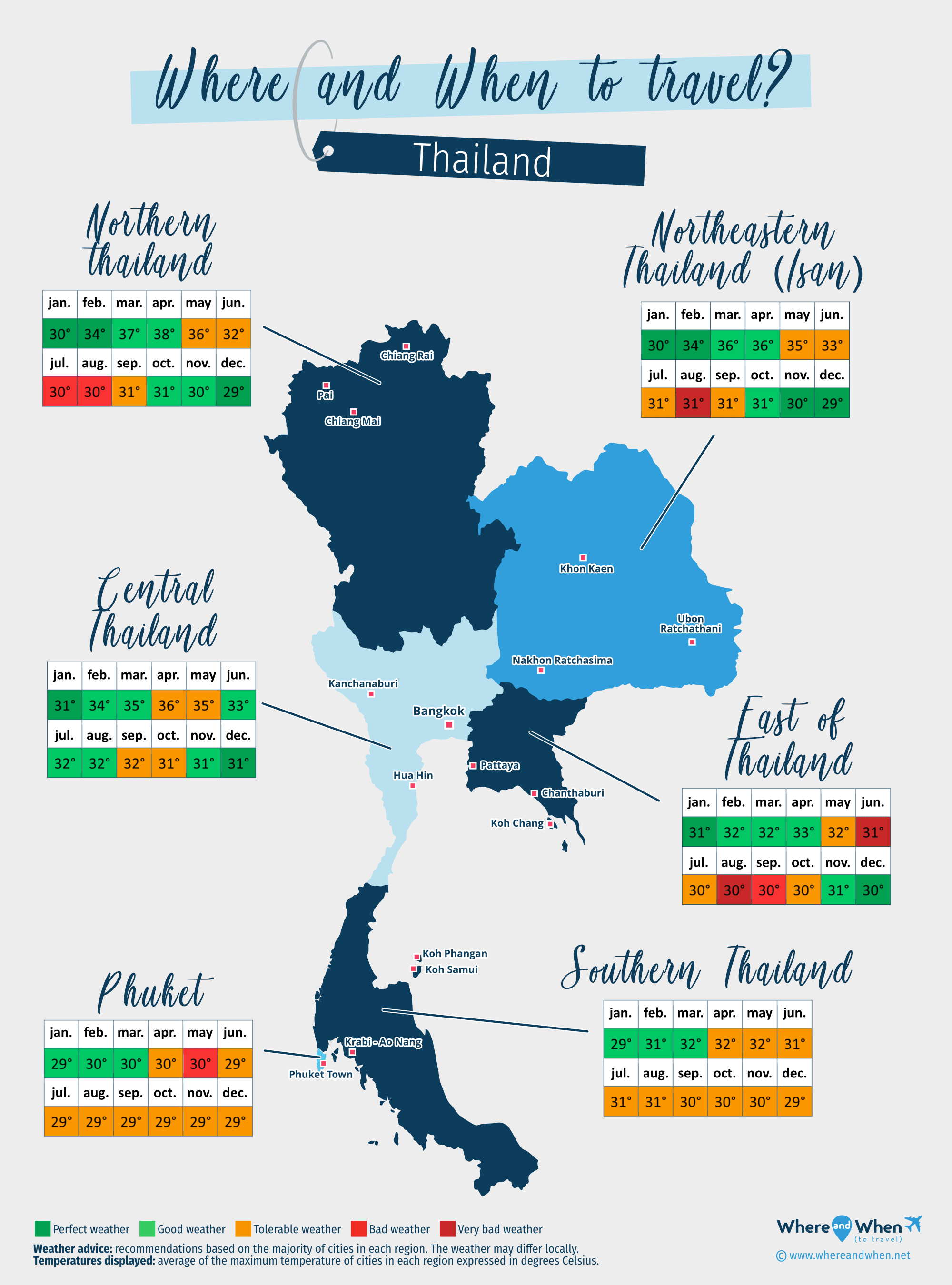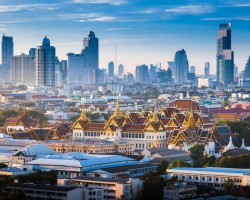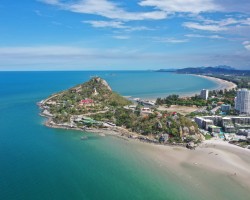Best time to go to Thailand for a perfect weather and where to go?
When is the best time to go to Thailand?
Throughout the year, temperatures in Thailand average between 26 and 34°C (94°F) . There are two seasons:
- The dry season from November to March brings pleasant temperatures and abundant sunshine, making it the best time to travel to Thailand.
- The wet season from April to October is characterized by heavy rainfall and often overcast skies.
The rainiest period is between September and October, which is also the time of typhoons and should be avoided. Additionally, from April to May, temperatures are very high and can be challenging for travelers.
There are significant climate differences across the country, with the North experiencing cooler temperatures compared to the Central and Southern regions.
So, when is the best time to visit Thailand? Generally, traveling from December to March ensures good weather everywhere, although this period coincides with the peak tourist season. In November, Chiang Mai's lantern festival attracts many visitors.
To make the most of your trip, it's best to avoid the period from May to October due to heavy rains and stifling heat. However, if you plan a beach holiday in Thailand during the summer (July-August), heading to the south of Thailand is recommended. The Gulf islands (Koh Tao, Koh Phangan, etc.) are preferable to Phuket.
Lastly, for a diving trip in Thailand, the ideal season is between November and April in the Andaman Sea and between February and August in the Gulf of Thailand.
Where and when to go based on the weather?

Central Thailand
Bangkok, Hua Hin, Kanchanaburi...
East of Thailand
Pattaya, Koh Chang, Chanthaburi...
Northeastern Thailand (Isan)
Khon Kaen, Ubon Ratchathani (Isan), Nakhon Ratchasima...
Northern thailand
Chiang Mai, Chiang Rai, Pai...
Phuket
Phuket town, Patong, Kata Beach...
Southern Thailand
Koh Samui, Khao Lak national Park, Krabi - Ao Nang...
To get all the information about the climate and weather in Thailand for a specific month, click on the corresponding link below:
Thailand in january Thailand in february Thailand in march Thailand in april Thailand in may Thailand in june Thailand in july Thailand in august Thailand in september Thailand in october Thailand in november Thailand in december
Best time to travel to Thailand by cities
Climate and Weather in Thailand
Located between Myanmar, Laos, Cambodia, and Malaysia, Thailand benefits from hot temperatures all year round. Average temperatures stay above 20°C (68°F) during the day throughout the year.
Thailand's climate is tropical in most regions. It is equatorial near the border with Malaysia (Phuket, Krabi, Koh Lanta), which means that precipitation is higher in these areas.
There are mainly two seasons: the dry season and the rainy season often referred to as the "green season." As we will see below, their timing varies by region.
In terms of temperatures and precipitation, there is also a marked difference between the south (Phuket, Ko Phi Phi) and the north of the peninsula (Chiang Mai, Chiang Rai).
Although the climate is generally good all year round in Thailand, it is best to avoid the months of September and October for your stay in the Kingdom of Siam. While typhoons are rare in the Gulf, they can still occur!

Climate in Northern Thailand
The climate in northern Thailand is similar to that of Myanmar. Generally, in this region, the weather is favorable from October to April, with pleasant temperatures and many sunny days.
Unlike the southern part of the country, the weather is more distinct in this region. In northern Thailand, you will experience colder winters and hotter summers.
For example, in the cities of Chiang Mai and Chiang Rai, during the months of December and January, temperatures can quickly drop in the evening and sometimes reach around 15°C (59°F) . On the other hand, temperatures are very high from March to May, regularly exceeding 35°C (95°F) . This period should be avoided for your trip.
There are several particularities in this region:
- The dry season extends from November to April: this is the ideal period for a stay.
- The cool season from November to February, with a cool breeze, especially at night, is the most pleasant. It offers beautiful days.
- The wet season, from May to November, experiences heavy rainfall. However, it is shorter than in the southern part of the country.
Climate in Central Thailand
The climate in central Thailand is relatively humid throughout the year. However, in Bangkok in particular, the dry season, from November to March, comes with a high level of sunshine.
During this period, temperatures are hot although they can drop in the evening. This season is the most favorable for planning a stay in the capital.
The hot season is between February and June in central Thailand. The heat combined with high humidity can be uncomfortable for travelers.
Next is the rainy season, which usually starts around July. The monsoon often extends until October. This period experiences heavy rainfall and high temperatures (over 33°C (92°F) on average).
Climate in Eastern Thailand
Eastern Thailand, Isan, is one of the wettest regions in the country. It is these significant precipitations that allow for the cultivation of rice and typical Thai fruits in this province.
Moreover, the East coast of Thailand, towards Pattaya, enjoys pleasant weather all year round with a particularly pleasant microclimate. The sun is regularly shining, and temperatures range between 26 and 33°C (92°F) .
However, during the months from April to November, showers and thunderstorms are common in this area, along with high heat. Although the rains are mostly at night, it is advisable to avoid this period for a stay. In November, for instance, there are usually 15 days of rain.
Climate in Southern Thailand
There are significant climate differences between southwest and southeast Thailand.
In general, the wet season lasts from April to October in the west, and from September to December in the east. But regardless of the southern part of the peninsula, there is more rainfall than in the north!
Here is information based on the various regions of Southern Thailand:
Climate in the Gulf of Thailand Islands
In the Gulf islands, such as Koh Samui, Koh Tao, or Koh Phangan, the climate is pleasant all year round, with mild and warm temperatures, without being stifling. There are three seasons:
- The hot season from February to May
- The rainy season from May to October, with the heaviest rains in October and November.
- The so-called "cool" season from November to January.
However, between May and October, it is still possible to visit this region. While the rain can be heavy, the showers are usually short-lived and quickly give way to the sun.
Nevertheless, the most popular period to visit the Gulf islands is typically between November and April.
Climate in Southwest Thailand
The Andaman Sea islands (Koh Phi Phi, Koh Lanta, Phuket) experience abundant rainfall from September to November. However, from January onwards, the showers become less frequent, giving way to the dry season. The sun shines, and the climate is particularly pleasant until April.
Then, there is a hot and rainy season from April to May.
As you may have understood, this region, close to Malaysia, experiences more precipitation than the rest of Thailand. Nevertheless, you can enjoy the beaches and resorts between showers for a large part of the year.
Temperatures and rainfall in Thailand
On these 3 graphs, we present the evolution of temperatures of Thailand and month-by-month rainfall for the cities of Bangkok, Phuket town, Chanthaburi, Chiang Mai and Chiang Rai, as well as the month-by-month sea temperature for coastal cities.

Peak visitor numbers and tourist seasons in Thailand
Find out when Thailand has its high tourist season (the period when the influx of tourists is highest) and off-peak tourist season using our data and figures.
Tourist seasons in Thailand
The months with low numbers of tourists are: March, April, May, June, July, August, September and October. The number of visitors to Thailand is high in: January, February, November and December.
- Very low season in Thailand: May, June and September.
- Low season in Thailand: March, April, July, August and October.
- High season in Thailand: January, February and November.
- Peak season in Thailand: December.
Figure: Visitor index for Thailand month by month
Average price for flights to Thailand
A return flight between Melbourne and Bangkok is generally cheaper if you go in may ($ 580 on average): this is the best time for travellers on a tight budget. In contrast, you may end up paying $ 336 more for your airline ticket to Bangkok if you go in december.
Where to go in Thailand?
This table allows you to see the maximum temperature for each city and our opinion on the weather month by month (see colour legend below the table).
| Cities | jan. | feb. | mar. | apr. | may | jun. | jul. | aug. | sep. | oct. | nov. | dec. |
| Bangkok | 92°F | 94°F | 95°F | 97°F | 97°F | 94°F | 92°F | 92°F | 92°F | 90°F | 92°F | 90°F |
| Phuket town | 85°F | 86°F | 88°F | 88°F | 86°F | 86°F | 85°F | 85°F | 85°F | 85°F | 86°F | 85°F |
| Chanthaburi | 90°F | 92°F | 92°F | 92°F | 92°F | 88°F | 86°F | 86°F | 86°F | 88°F | 90°F | 88°F |
| Chiang Mai | 86°F | 95°F | 101°F | 103°F | 99°F | 92°F | 90°F | 90°F | 92°F | 90°F | 88°F | 86°F |
| Chiang Rai | 86°F | 94°F | 99°F | 103°F | 99°F | 92°F | 88°F | 88°F | 90°F | 90°F | 88°F | 85°F |
| Hua Hin | 85°F | 88°F | 90°F | 92°F | 92°F | 90°F | 88°F | 88°F | 88°F | 86°F | 86°F | 85°F |
| Kanchanaburi | 92°F | 99°F | 101°F | 103°F | 101°F | 95°F | 92°F | 92°F | 92°F | 90°F | 88°F | 88°F |
| Khao Lak national Park | 86°F | 88°F | 90°F | 88°F | 88°F | 86°F | 86°F | 86°F | 86°F | 86°F | 86°F | 86°F |
| Khon Kaen | 88°F | 94°F | 97°F | 99°F | 97°F | 94°F | 90°F | 90°F | 90°F | 88°F | 88°F | 86°F |
| Koh Chang | 90°F | 92°F | 92°F | 92°F | 92°F | 88°F | 86°F | 86°F | 86°F | 88°F | 90°F | 88°F |
| Koh Lanta | 86°F | 86°F | 86°F | 88°F | 88°F | 86°F | 86°F | 86°F | 85°F | 86°F | 86°F | 86°F |
| Koh Phangan | 83°F | 83°F | 85°F | 86°F | 88°F | 86°F | 86°F | 86°F | 85°F | 85°F | 85°F | 85°F |
| Koh Phi Phi | 85°F | 86°F | 86°F | 88°F | 88°F | 86°F | 86°F | 86°F | 85°F | 85°F | 85°F | 85°F |
| Koh Samui | 83°F | 83°F | 85°F | 86°F | 88°F | 86°F | 86°F | 86°F | 86°F | 85°F | 85°F | 85°F |
| Koh Tao | 83°F | 83°F | 85°F | 86°F | 88°F | 86°F | 86°F | 86°F | 85°F | 85°F | 85°F | 85°F |
| Krabi - Ao Nang | 88°F | 92°F | 94°F | 92°F | 90°F | 88°F | 86°F | 88°F | 86°F | 88°F | 88°F | 88°F |
| Nakhon Ratchasima | 88°F | 95°F | 99°F | 99°F | 97°F | 94°F | 90°F | 90°F | 90°F | 88°F | 86°F | 86°F |
| Pattaya | 88°F | 88°F | 90°F | 92°F | 90°F | 88°F | 86°F | 86°F | 86°F | 86°F | 88°F | 86°F |
| Ubon Ratchathani (Isan) | 88°F | 95°F | 97°F | 97°F | 95°F | 92°F | 90°F | 88°F | 88°F | 88°F | 88°F | 86°F |
| Patong | 85°F | 86°F | 88°F | 88°F | 86°F | 86°F | 85°F | 85°F | 85°F | 85°F | 86°F | 85°F |
Legend:
perfect weather
good weather
tolerable weather
bad weather
very bad weather
About Thailand
What can I do in Thailand?
Beaches / swimming
Nature and countryside
Culture and heritage
Sports
Family travel
Crafts / shopping
Gastronomy
Nightlife
Is this weather information for Thailand reliable?
Climate data for Thailand has been gathered every day since January 2009. The analysis of these meteorological data for Thailand allows us to determine the average for each month in Bangkok, Phuket town, Chanthaburi, Chiang Mai, Chiang Rai, Hua Hin, Kanchanaburi, Khao Lak national Park, and 131 other cities.
So yes: this data is reliable except in cases of temporary climate disruption in the region.
















